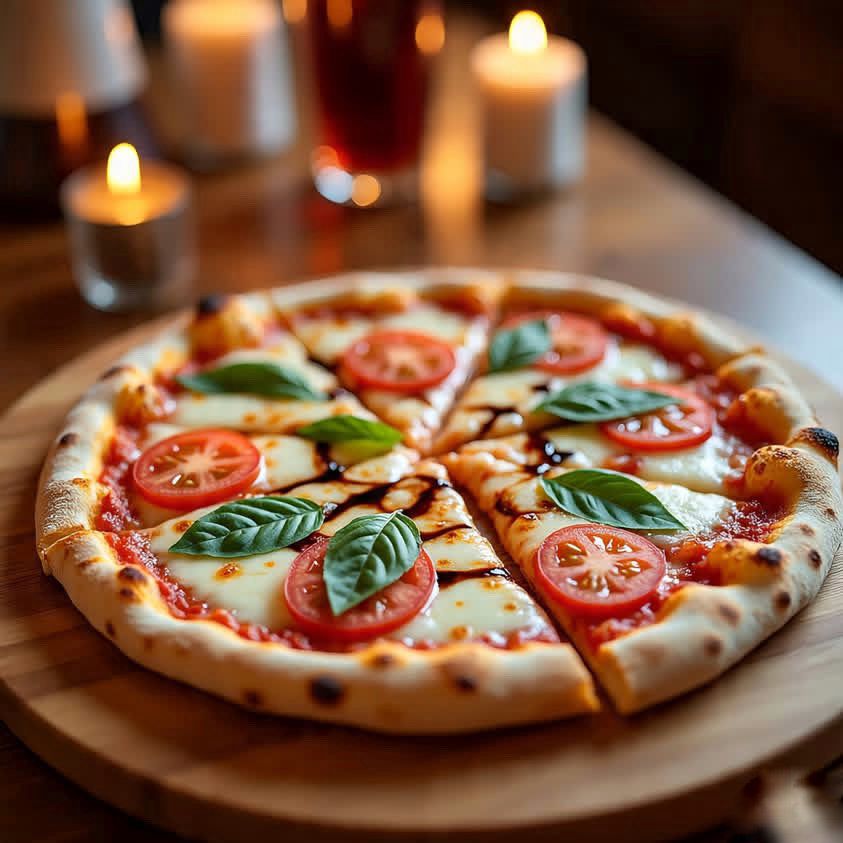Learn how fresh mozzarella, ripe tomatoes, and basil create the perfect pizza topping combination. Last summer, I found myself staring at my garden overflowing with basil and cherry tomatoes, wondering what to do with this abundance. My neighbor had just dropped off some fresh mozzarella from the local farmers market, and suddenly it hit me – why not turn the classic Caprese salad into a pizza? That moment changed everything about how I think about pizza toppings.
The beauty of Caprese pizza lies in its simplicity, much like its salad counterpart. But when you transform those familiar flavors onto a crispy pizza crust, something extraordinary happens. The heat from the oven transforms each ingredient while maintaining their individual character. The mozzarella melts into creamy pools, the tomatoes release their sweet juices, and the basil becomes aromatic and slightly wilted but still vibrant green.
I remember the first time I attempted this pizza topping combination. I was skeptical, honestly. Could something so simple really compete with loaded pizzas packed with multiple meats and vegetables? The answer came with that first bite. The fresh mozzarella had created these incredible pockets of creamy cheese that contrasted beautifully with the bright acidity of the tomatoes. The basil added that perfect herbal note that tied everything together.
What makes Caprese pizza particularly appealing is how it celebrates the quality of each ingredient rather than masking flavors. Unlike heavy pizza combinations that can become overwhelming, this approach lets you taste everything. The tomatoes need to be ripe and flavorful – I learned this the hard way when I used bland winter tomatoes once and the entire pizza fell flat. Fresh mozzarella makes all the difference too, though I have successfully used good quality low-moisture mozzarella when fresh was not available.

The technique for assembling Caprese pizza matters more than you might think. I start with a light coating of olive oil instead of traditional pizza sauce, though some people prefer a thin layer of marinara. The key is restraint. Too much sauce competes with the fresh tomato flavor. Then comes the mozzarella, torn into irregular pieces rather than sliced. This creates those beautiful melted cheese pockets I mentioned earlier.
Timing becomes crucial with the tomatoes. Add them too early and they release too much moisture, making the crust soggy. Too late and they do not warm through properly. I typically add halved cherry tomatoes about halfway through the baking process, allowing them to soften and caramelize slightly without turning to mush.
The basil presents its own challenge. Fresh basil burns easily in the high heat of pizza ovens, so I add it after baking. Some pizza makers add it during the last minute of cooking, but I prefer the bright, fresh taste you get from adding it to the hot pizza immediately after it comes out of the oven. The residual heat wilts the basil just enough while preserving that distinctive aroma.
Over time, I have experimented with variations on the classic Caprese pizza theme. A drizzle of balsamic glaze after baking adds a sweet tanginess that complements the other flavors beautifully. Sometimes I add thin slices of fresh garlic before baking, or scatter a few pine nuts for extra texture. Prosciutto makes an excellent addition if you want to include some meat, though purists might object.

The seasonal nature of this pizza topping combination makes it even more special. Peak summer ingredients create the best results, making this pizza a celebration of the season. When tomatoes are at their ripest and basil is abundant in gardens everywhere, Caprese pizza becomes more than just dinner – it becomes a way to capture summer on a plate.
Making this pizza at home requires no special equipment beyond a decent oven and pizza stone or baking sheet. The ingredient list is short and most items are readily available year-round, though quality matters significantly. I have made successful versions using store-bought pizza dough when time was limited, though homemade dough elevates the experience considerably.
What surprises people most about Caprese pizza is how satisfying it feels despite being relatively light compared to meat-heavy alternatives. The combination of protein from the mozzarella, the freshness of the vegetables, and the aromatic herbs creates a balanced meal that does not leave you feeling overly full.
This pizza topping combination taught me that sometimes the best culinary innovations come from taking something familiar and presenting it in a new way. The Caprese salad has been beloved for generations, and transforming those same flavors into pizza form feels both natural and inspired. Every time I make one, I am reminded that good food does not need to be complicated – it just needs to be made with care and quality ingredients.
Reference
Barrett, D. M., & Lloyd, C. (2012). Advanced preservation methods and nutrient retention in fruits and vegetables. Journal of the Science of Food and Agriculture, 92(1), 7–22.
Benedetti, S., et al. (2018). Antioxidant properties of Mediterranean herbs: Focus on rosemary and basil essential oils. Food Chemistry, 247, 986–993.
Guinard, J. X., & Mazzucchelli, R. (1996). The sensory perception of texture and mouthfeel. Trends in Food Science & Technology, 7(7), 213–219.

